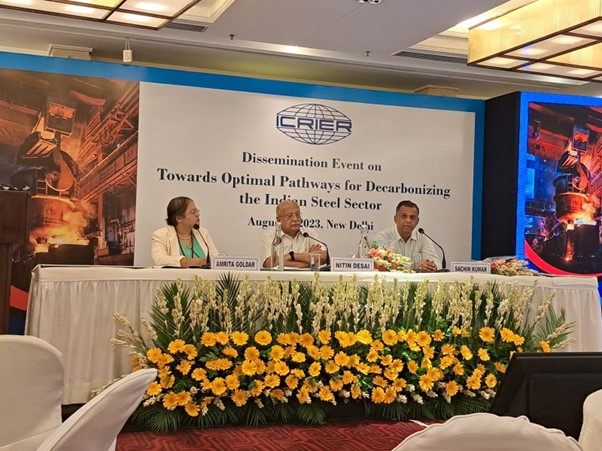
An event was organised by ICRIER on ‘Towards Optimal Pathways for Decarbonising the Indian Steel Sector’ on August 9, 2023, to deliberate on the outcomes of the Shakti-supported study on landscape review of the policy levers of top steel-producing countries to transition towards a carbon-neutral steel sector and understanding the impact of Carbon Border Adjustment Mechanism (CBAM) on the Indian steel sector. Two policy briefs were also released as an outcome. The first was based on research on the policy landscape of top steel-producing G20 countries and suitable policy options that India can adopt to decarbonize its steel sector. It discusses the three levers— Supply-side policy levers, Demand-side and Export promotions for steel sector decarbonisation. Another released brief was focused on the impact of CBAM on India’s global iron and steel trade.
Mr Nitin Desai, Former Under-Secretary-General at the United Nations, current member of ICRIER’s Board of Governance, and current board member at Shakti delivered his welcome address at this event. Dr Sachin Kumar, Director, Industry, Building and Cooling Programme at Shakti also delivered an inaugural address in this dissemination workshop. He said “Iron & Steel, one of the most important industry subsectors for India, is the focus of intervention for Shakti. The idea is to support the Government of India’s initiatives and facilitate the development of an eco-system to achieve net-zero steel sector in the country.”
The event was organised in two dedicated sessions of discussion moderated by Dr Amrita Goldar, Senior Fellow and Thematic Lead, CCUS, ICRIER, as provided below:
Session 1: Prioritising Policies for the Carbon-Neutral Steel
The panellists were from TERI, The Climate Group, and Shell. They deliberated on the importance of CCUS, energy efficiency, viable gap funding (VGF), challenges for MSME in the steel sector, the expected demand for steel in the government and private sector, the necessity of green public procurement, the requirement of green taxonomy, technology support, and challenges like land and transportation costs for low TRL technologies. The session provided important suggestions including the importance of VGF for CAPEX, expected carbon financing to manage OPEX for newer technologies if the carbon compliance market under article 6.2 opens up; requirement of financial support for demonstration and scale-up of TRL 4 technologies; and requirement of common infrastructure facility such as piped NG or H2 for reducing the cost of transportation and easy access to fuel. It was also emphasised that the Government can play a dual role in the ecosystem, one as a setter of rules which also includes defining green steel whereas another as a consumer of green steel.
Session 2: Exploring the Impact of EU’s CBAM on India’s Steel Trade
The featured experts for this session were from WRI, CEEW and CSEP. They discussed the significance of CBAM, carbon pricing, the role of clean electricity and electrification in reducing carbon emissions, the need for green hydrogen for the steel sector, the skilling requirements for new job opportunities, and the disparity between India’s steel production and that of other major producers. The discussion concluded with the realisation that there is a need for careful consideration to avoid protectionism under the guise of carbon consciousness.
